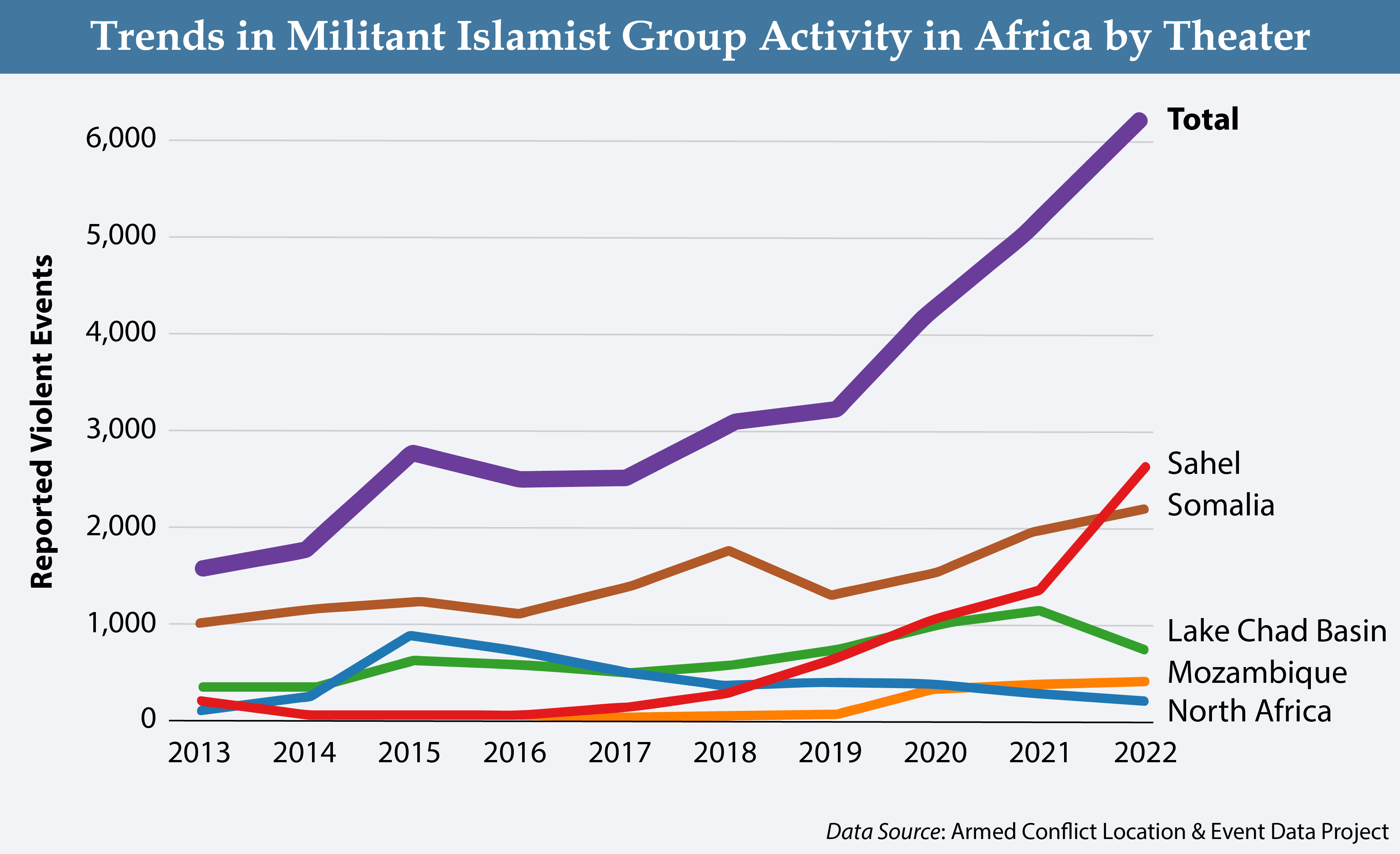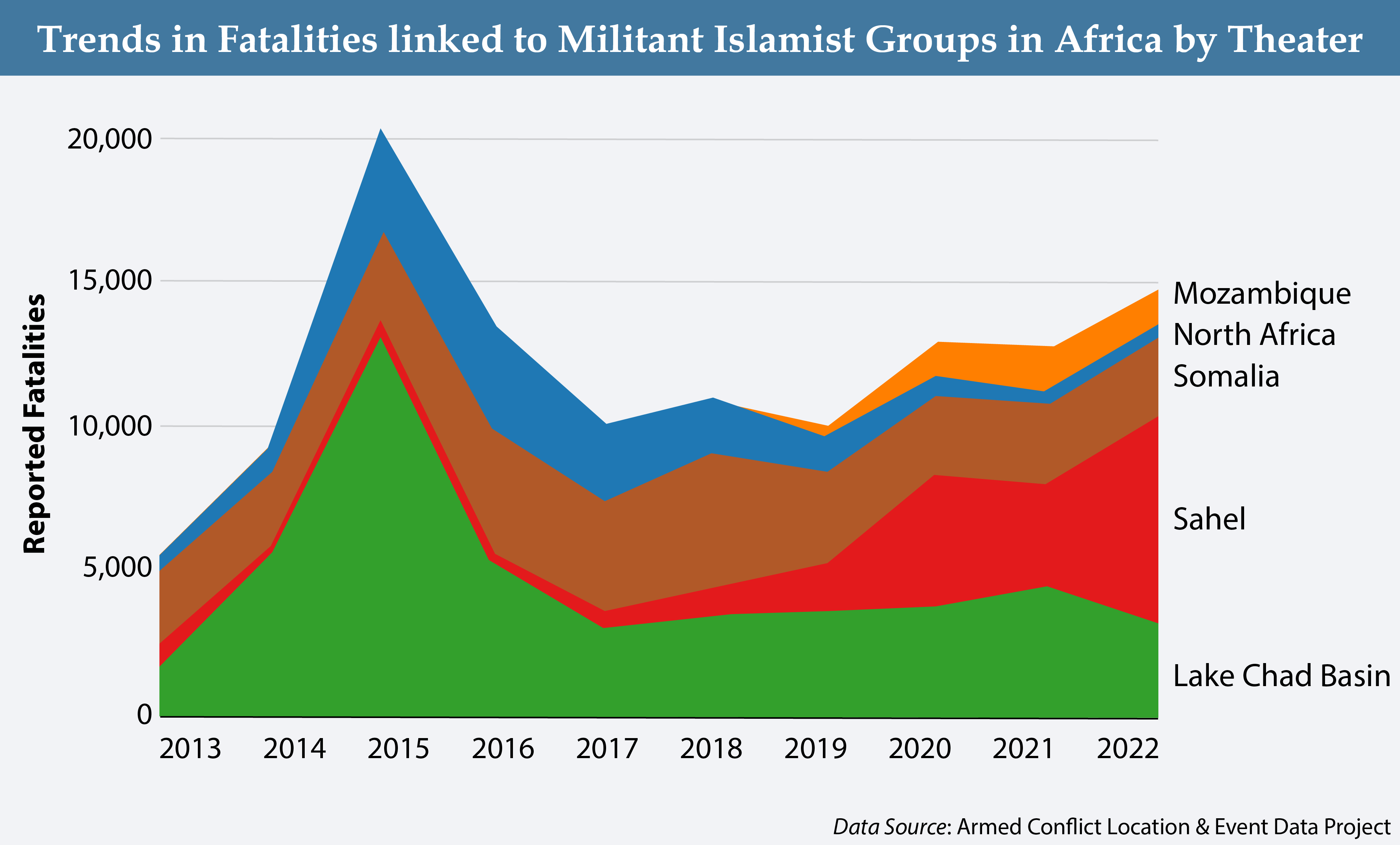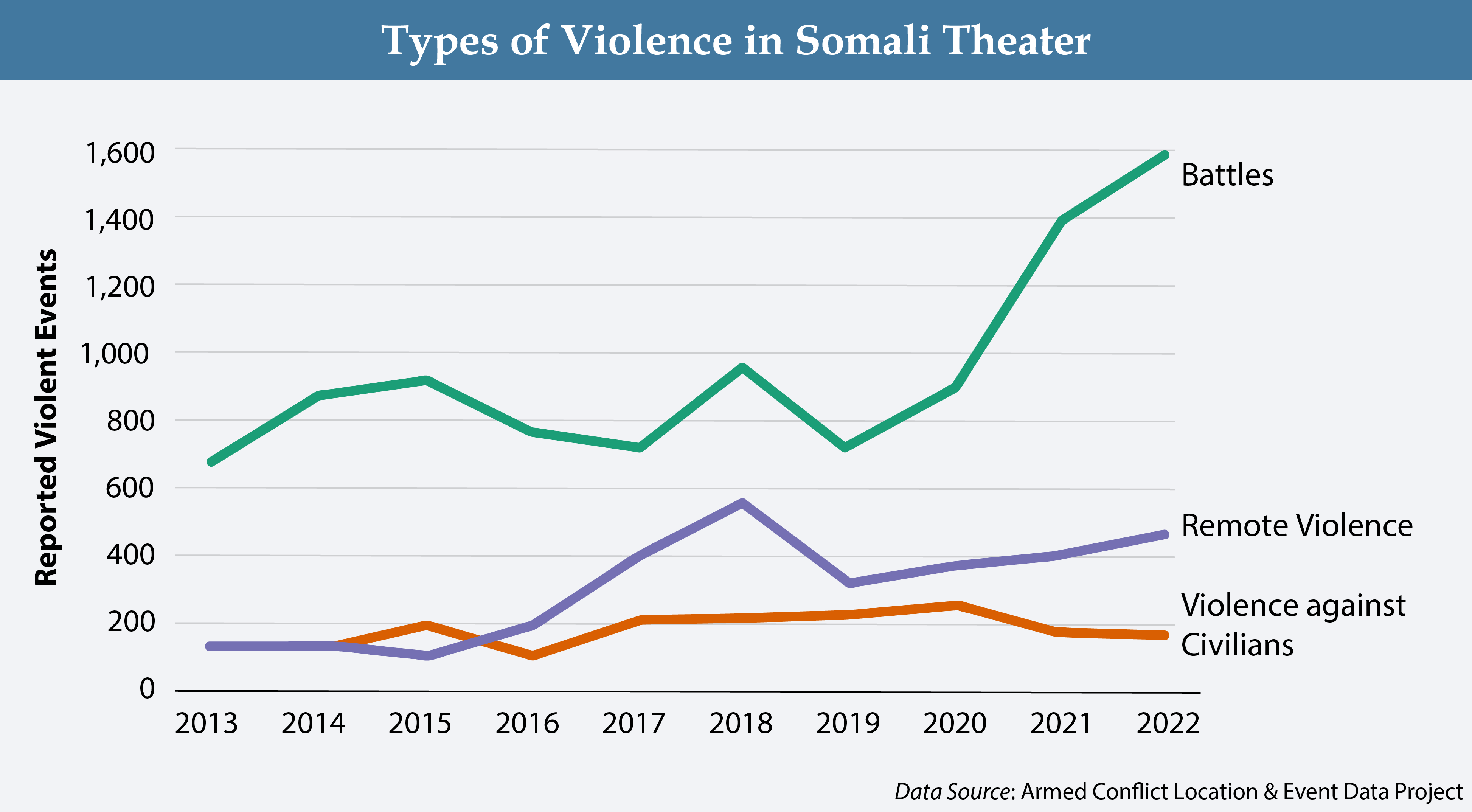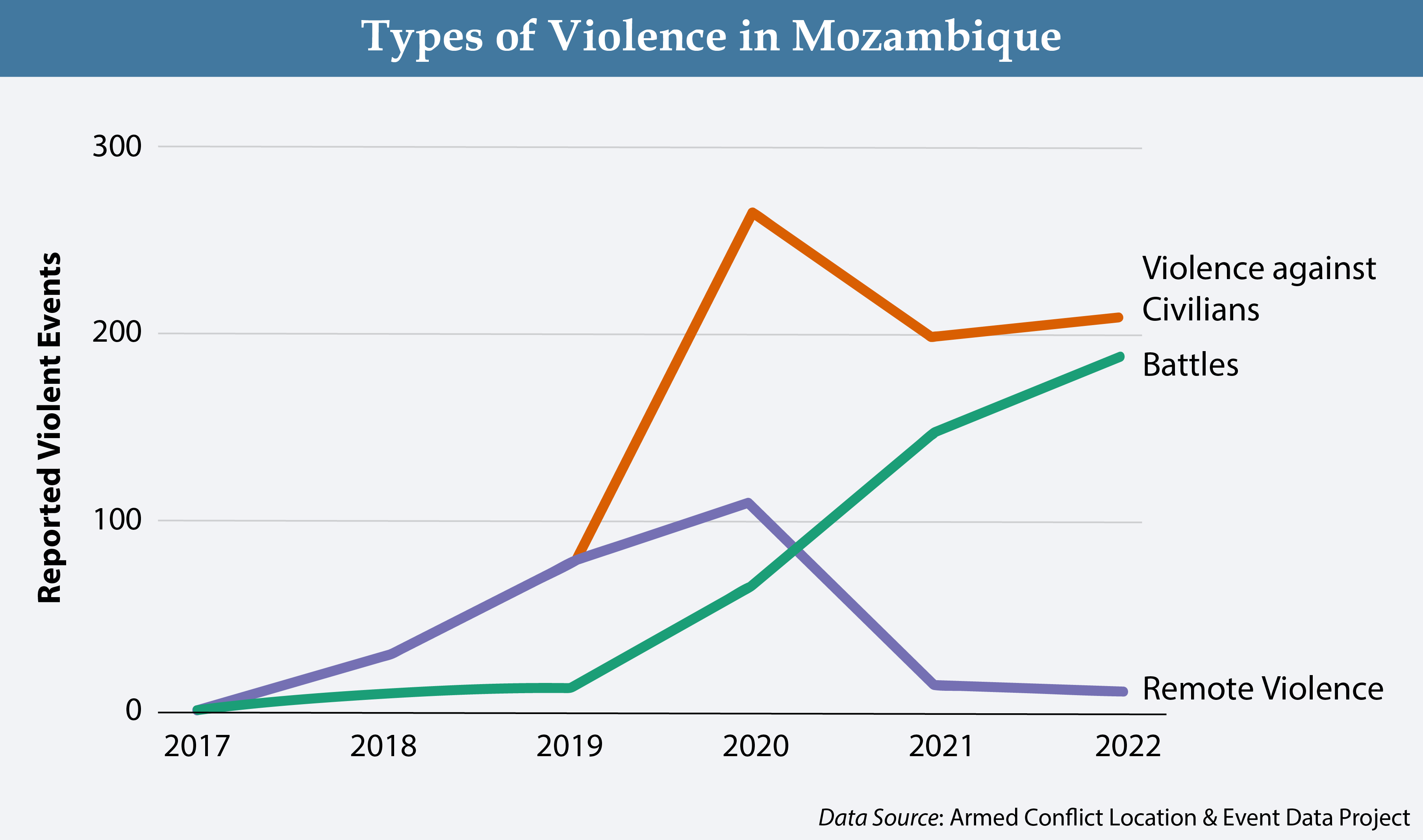A review of violence involving African militant Islamist groups over the past decade underscores the continuing, although varied, escalation of this threat.
Key findings include:
- Militant Islamist group violence in Africa has risen inexorably over the past decade, expanding by 300 percent during this time. Violent events linked to militant Islamist groups have doubled since 2019.
- Roughly 95 percent of the increase in militant Islamist violence on the continent since 2019 comes from two theaters—the western Sahel and Somalia.
- There has been progress in the fight against militant Islamist groups in Africa, though. Underscoring the great variance across regions, militant Islamist violence in the Lake Chad Basin and North Africa declined by 33 percent and 23 percent, respectively, over the last year.
- The record 6,255 violent events linked to these groups in 2022 represents a 21-percent increase from the previous year. This is close to the 18-percent average annual increase observed on the continent over the past decade.
- Fatalities linked to militant Islamist groups have also been on the rise, reaching 14,635 in the past year—a nearly 50-percent increase since 2019.
Sahel
- The Sahel has seen a quadrupling in the number of violent extremist events since 2019. Along with Mozambique, this is the sharpest spike in violence of any region on the continent during this timeframe.
- The 2,612 violent events in the Sahel over the past year is the first time a theater other than Somalia experienced the greatest level of Islamist militant-linked violence. The majority of this increase is being generated by the Macina Liberation Front (FLM), part of the Jama’at Nusrat al Islam wal Muslimin (JNIM) coalition of militant Islamist groups.
- The 7,052 fatalities linked to militant Islamist groups in the Sahel represent nearly half of all such deaths reported on the continent.
- Over a quarter of the fatalities reported in the Sahel in 2022 were the result of attacks on civilians (1,847). This marks a 67-percent spike over 2021. Notably, the Islamic State in the Greater Sahara (ISGS) was linked to 63 percent of civilian fatalities, even though it was associated with less than 30 percent of violent events. This continues a pattern of disproportionate ISGS violence against civilians observed over the past decade.
- While still less than one percent of militant Islamist group violence in the Sahel, there has been an increase in these episodes in West Africa’s littoral states. Benin, Côte d’Ivoire, and Togo have experienced nearly 20 violent events in the past year.
Somalia
- While not the surge observed in the Sahel, Somalia continues to see a steady rise in militant Islamist events and fatalities, increasing 11 percent over the past year. The record 2,221 violent events reported are a 45-percent increase from the 3-year average from 2018-2020. Al Shabaab was linked to 36 percent of all militant Islamist group violence recorded on the continent this past year.
- Much of the increase in violent events involving al Shabaab in recent years has been a result of a spike in battles involving state security forces. Battles account for 72 percent of all violent events involving al Shabaab in 2022—more than any other militant Islamist group theater on the continent. As a point of comparison, in 2019, battles represented 56 percent of all violent events involving al Shabaab.
Mozambique
- After spiking in 2018 to 2020, violent events linked to Ahlu Sunnah wa Jama’a (ASWJ), also known locally as al Shabaab, have moderated in recent years—though they are still on the rise. The 405 violent episodes in 2022 are 17 percent greater than 2020.
- For the first time since emerging on the scene in 2017, the reported fatality count linked to ASWJ decreased over the last year—down 28 percent to 1,018. This is noteworthy in that a distinctive feature of ASWJ has been its disproportionate reliance on violence against civilians.
- This drop in fatalities coincides with the arrival of SADC and Rwandan forces. Over the past year there was a 27-percent increase in battles linked to ASWJ. Nevertheless, attacks on civilians still constituted 52 percent of violent events linked to ASWJ. Though civilian fatalities linked to ASWJ attacks have dropped, the number of civilians displaced now stands at over 947,000, a 25-percent increase from a year ago.
Lake Chad Basin
- The Lake Chad Basin saw a 33-percent decrease in militant Islamist violence over the last year. This reverses an upward trend observed since 2017.
- Boko Haram, which last peaked in 2020, saw a further 25-percent drop in violent events linked to it. This roughly coincides with the death of its longtime leader, Abubakar Shekau, in May of 2021.
- Long known for its use of violence against civilians, Boko Haram has seen the number of civilian fatalities linked to it decline by 42 percent from the level recorded in 2018. Nonetheless, 45 percent of the violent events linked to Boko Haram continue to be attacks on civilians.
- The Islamic State of West Africa (ISWA), similarly, saw a 38-percent drop in violent activity this past year—to 474 events. This reverses a strong upward trajectory of violent activity ISWA had been on since 2017.
- Though ISWA committed virtually the same number of attacks on civilians as Boko Haram this past year, the number of civilian fatalities linked to ISWA (345) were nearly double that of Boko Haram (184). This constitutes a 50-percent increase in ISWA’s civilian fatalities from the previous year, even though the overall number of fatalities linked to militant Islamist groups in the Lake Chad region declined by 27 percent during this time.
- Operating from a base in northwestern Nigeria where banditry has been rapidly escalating over the last few years, Ansaru, which resurfaced in 2020 after a 5-year hiatus, has maintained a limited presence thus far.
North Africa
- Militant Islamist activity and related fatalities in North Africa dropped by 23 percent over the past year, continuing a trend since 2015. Virtually all 222 violent events and 313 fatalities reported in North Africa over the past year were in Egypt and linked to the Islamic State in the Sinai Province. These figures represent a 50-percent decline in violent episodes since 2019. Fatalities are less than 10 percent of the levels seen in 2015 and 2016.






